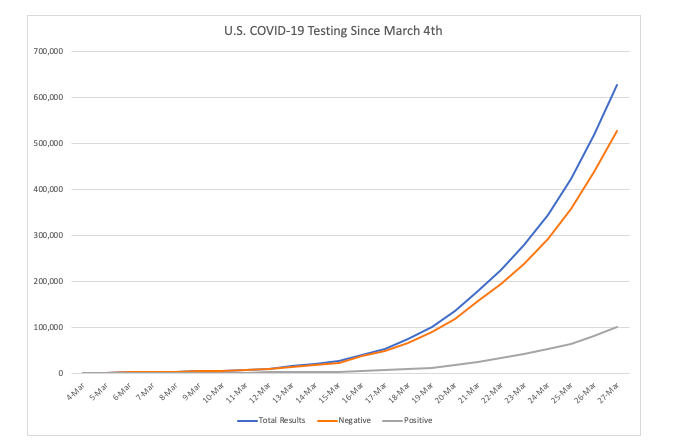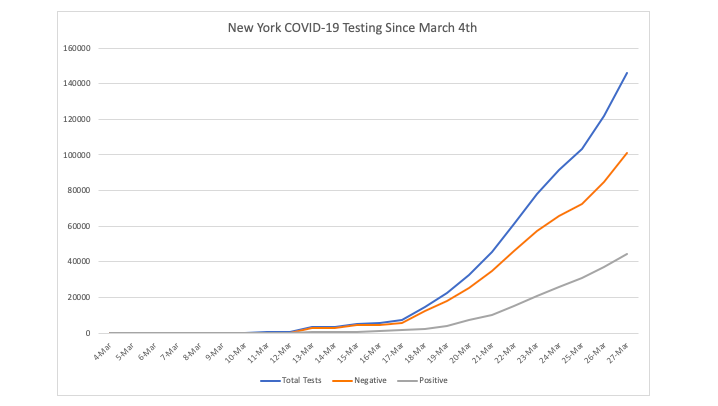
When the history of coronavirus is written, the heroic work of Helen Y. Chu, a flu researcher at the University of Washington, will be worthy of recognition.
This infuriating account comes from LeapsMag.com:
In late January, Chu was testing nasal swabs for the Seattle Flu Study to monitor influenza spread when she learned of the first case of COVID-19 in Washington state. She deemed it a pressing public health matter to document if and how the illness was spreading locally, so that early containment efforts could succeed. So she sought regulatory approval to adapt the Flu Study to test for the coronavirus, but the federal government denied the request because the original project was funded to study only influenza.
Aware of the urgency, Chu’s team bravely defied the order and conducted the testing anyway. Soon they identified a local case in a teenager without any travel history, followed by others. Still, the government tried to shutter their efforts until the outbreak grew dangerous enough to command attention.
Needless testing delays, prompted by excessive regulatory interference, eliminated any chances of curbing the pandemic at its initial stages. Even after Chu went out on a limb to sound alarms, a heavy-handed bureaucracy crushed the nation’s ability to roll out early and widespread testing across the country. The Centers for Disease Control and Prevention infamously blundered its own test, while also impeding state and private labs from coming on board, fueling a massive shortage.
The long holdup created “a backlog of testing that needed to be done,” says Amesh Adalja, an infectious disease specialist who is a senior scholar at the Johns Hopkins University Center for Health Security.
In a public health crisis, “the ideal situation” would allow the government’s test to be “supplanted by private laboratories” without such “a lag in that transition,” Adalja says. Only after the eventual release of CDC’s test could private industry “begin in earnest” to develop its own versions under the Food and Drug Administration’s emergency use authorization.
In a statement, CDC acknowledged that “this process has not gone as smoothly as we would have liked, but there is currently no backlog for testing at CDC.”
Now, universities and corporations are in a race against time, playing catch up as the virus continues its relentless spread, also afflicting many health care workers on the front lines.
Hospitals are attempting to add the novel coronavirus to the testing panel of their existent diagnostic machines, which would reduce the results processing time from 48 hours to as little as four hours. Meanwhile, at least four companies announced plans to deliver at-home collection tests to help meet the demand – before a startling injunction by the FDA halted their plans.
[Read the rest of the article here.]
And why hasn’t Taiwan shut down its economy?
Geographically, it’s very close to the Chinese mainland, and yet relatively few people in Taiwan have been infected. The same is true of Singapore and Hong Kong.
How did Taiwan and the others — South Korea included — achieve this? It wasn’t through coercion and force but just the opposite: by allowing the free flow of knowledge and the voluntary action that this knowledge fosters — more informed people able because of this to more wisely choose.
As Javier Caramés Sanchez and William Hongsong Wang recently wrote:
“At the moment in Taiwan, the infection has been completely contained despite being one of the countries with the highest risk of suffering a pandemic, given that the Republic of China (ROC) is very close to the Chinese mainland (the People’s Republic of China (PRC)). Until January there were flights between Taiwan’s capital, Taipei, and the epicenter of Wuhan, China. However, as of March 21 there were only 153 infected at the same time that Europe, far away from the Chinese mainland, has more than ten thousand affected by the coronavirus. However, in Taiwan and other parts of Asia, including Singapore and Hong Kong, no massive mandatory quarantine or containment has been applied so far.
“The first cause of Taiwan’s success is the transparency of information, which stopped the rapid growth of infection. The containment in Taiwan has been carried out with relatively high transparency. As early as December 31 of last year the Ministry of Health and Welfare of Taiwan began to take serious the potential danger of the Wuhan pneumonia, informing citizens every day about the developing trends of the infection and its status. The information provided by the Taiwanese authority also includes whether the infected in Taiwan contracted the illness from overseas input, which helps people take measures to protect themselves in a timely manner. In the constant press conferences, the Taiwanese government provides different options and recommendation that people can choose to adopt voluntarily but are not imposed coercively. The abundant information provided continuously has allowed individuals to make their own informed and balanced decisions under conditions of uncertainty. In contrast, the governments of the European Union countries reacted slowly and as late as February did not provide sufficient information about the potential pandemic, making the situation difficult to handle.
Voluntary Decision-Making and Cooperation among Individuals and Private Sectors
The type of quarantines established by the Taiwanese government are mostly self-quarantines. The Taiwanese government acknowledges that it is crucial to rely on people’s voluntary actions to resist the pandemic. As we have noted above, most cases of contagion in Taiwan come from outside and are almost always detected at the border.Taiwanese people’s voluntary self-protection is effectively suppressing the spread of the coronavirus in their country…
“As the Austrian school of economics demonstrates in the calculation theory of socialism, no central planning body has the capacity to organize society based on coercive mandates. The main reason is that the central planner is unable to obtain all the necessary information to organize society in this way, as information has subjective, creative, dispersed, and tacit qualities. This principle is fully applicable to the containment of a pandemic. Individual responsibility along with transparency of information are crucial to stopping a pandemic. Taiwan makes a very good case for how individualism and voluntary cooperation work effectively in resisting the coronavirus pandemic.”
[Read the full article here.]
The alternative to the lockdown strategy in the fight against Covid-19:
The current coronavirus strategy of most governments is a recipe for a worldwide economic disaster. In many countries, the strategy of confinement and forcing shops to close is a sure-fire path to large-scale business failures. The cascade of economic and financial repercussions to come is likely to lead to another Great Depression.
The Costs of Prolongation
Italy, for example, already had a 135 percent debt-to-GDP ratio before the crisis. It is hard to imagine how it will be able to borrow more without a commitment from other European countries to jointly be responsible for more Italian debt—something the northern European countries are still strongly opposed to. The ECB is already printing money like crazy, and another Greece-like situation will make it ramp up the printing presses even more. We have been down this path many times before, where the cure is clearly much worse than the disease. The German hyperinflation of 1921-1923 created a resentful, impoverished middle class which ultimately led to Hitler’s rise to power.
The coronavirus (SARS-CoV-2) that originated in China is highly contagious. More than 80 percent of the patients show only mild flu-like symptoms but for the remaining 20 percent, mostly the elderly or people with preexisting conditions, the virus can be life-threatening. To save lives short term, the entire population in Europe is currently being held under house arrest and many businesses have been put into a pre-liquidation state by no longer being able to realize a profit due to inactivity.
The current strategy is not to stop the virus in its tracks but to spread out the contagion so that the peak is a level that will be more manageable for the health care system. Governments took the biased advice of health care professionals without a real weighing of all the pros and cons. This prolongation in time, however, will come at a steep economic and human cost.
Unemployment Correlates with Death
In the longer term, more lives will be lost if we continue this strategy. How many victims of financial ruin will end their own lives? In the modern era, for every one percent increase in the unemployment rate, there has typically been an increase of about one percent in the number of suicides. A study conducted by Brenner in 19791, found that for every 10 percent increase in the unemployment rate, mortality increased by 1.2 percent, cardiovascular disease by 1.7 percent, cirrhosis of the liver by 1.3 percent, suicides by 1.7%, arrests by 4 percent, and reported assaults by 0.8 percent (see here). How many lost lives out of 300 million in the USA does a 10 percent, 15 percent, 20 percent unemployment rate represent?
The use of the free market gives another strategy to control the spread of the coronavirus. For example, we now have strong evidence from trials in France and China that in 75 percent of the cases a combination of two extremely well-known antimalarial drugs (hydroxychloroquine in combination with the antibiotic azithromycin) can bring the viral load down to nearly zero after just six days (complications usually arrive after the 6th day). These drugs could make the latent effects of the Wuhan virus as mild for 20 percent as the other 80 percent, and they were recently cleared for use.
There are many other possible drug combinations that might offer similar results, but FDA and EMA regulations requiring long term testing make it much more difficult for these drugs to be available in time to treat the virus. Yet the world economy is at stake and we cannot sit and argue on the quality of the water while our house is burning down.
An obviously better solution than sinking the world economy into a great depression is a greater use of “laissez-faire.” The current lockdown strategy is a bleak choice of (allegedly) fewer short term deaths against a much larger long-term death toll. We must return to a business-as-normal situation as soon as possible. We need to free drugs from overbearing drug regulations and make them widely available (with appropriate dosages and warnings) everywhere at a market price without the need for a prescription. We need markets to be free so they can provide a wide choice of medications.
The argument is not for a non-strategy; it is for allowing voluntary choices to define the strategy. For example, the elderly might consider taking chloroquine preventively [as many doctors in New York City are]; it has a long history of being taken to prevent malaria in Africa. It is naïve to think that people can’t inform themselves and take appropriate actions for their own health benefits.
It is also naïve to think that businesses and people won’t adapt to the perceived threat. Restaurants can seat patrons several meters apart. Waiters and cooks can wear masks and gloves. There is an infinite number of innovative ways people will adjust. Just because we cannot imagine a voluntary market solution does not mean one does not exist. South Korea is an example to emulate. Instead of an authoritarian locking down of its people, it took a much more libertarian approach to the problem and is already showing promising results.
(Link)

















